Rehab for Rotator Cuff Tears: What to Know
Arm Injuries

Your aching shoulder could be a rotator cuff tear — here’s how to get it moving pain-free again.
According to an estimate from the American Academy of Orthopedic Surgeons, about 2 million people in the U.S. visit their doctors each year for care due to rotator cuff tears, making it one of the most common orthopedic conditions requiring treatment.
A rotator cuff tear can leave you unable to exercise or perform simple everyday activities like reaching for an object on a shelf without pain. However, it can be treated successfully with physical therapy – provided you seek treatment immediately at the first signs of pain. The sooner you begin your rehab for a rotator cuff tear, the sooner you can regain full function of your shoulder. Let’s take a closer look at what causes a rotator cuff tear and how physical therapy is your best option to get your shoulder moving again.
What you need to know about a rotator cuff tear
Your shoulder is a complex joint composed of bones and tendons. The bones include the upper arm bone (humerus), the scapula (shoulder blade), and the clavicle (collarbone). At the head of the upper arm is a ball that fits snugly into the socket in the shoulder blade. Attached to the bones is a group of tendons collectively known as the rotator cuff. It’s because of the rotator cuff that you’re able to lift and rotate your shoulder.
However, that movement can be severely restricted when the rotator cuff is torn due to a sudden trauma, like a fall or accident. A rotator cuff tear can also develop over time as the tendons fray from overuse. Athletes who repetitively perform overhand motions, such as baseball pitchers and tennis players, stand the highest chance of developing a rotator cuff tear. But anyone who lifts overhead for their work is also at risk, including painters and carpenters.
Rotator cuff tears are more common as we age due to normal wear and tear on the tendons. According to Brown University Health, 10-15% of people aged 50 to 59 have a tear, with that percentage rising to nearly 50% for those aged 80 and over.
Common symptoms of a rotator cuff tear include:
- Sudden, intense pain after a fall or accident
- Persistent shoulder pain, especially at night or when lifting your arm
- Weakness in the affected arm
- A crackling sensation when moving the shoulder
Whatever the symptoms, don’t ignore your shoulder pain. Delaying rehab for a rotator cuff tear will only make it worse. Physical therapy is the first step to healing your shoulder. Check with your doctor and insurer about what you need to do before starting physical therapy.
Exercises to rehab rotator cuff tears

To diagnose a rotator cuff tear, your doctor will order an MRI to get a closer look at the tendons. Rotator cuff tears can either be partial, which means the tendon is torn but still attached to the bone, or complete. In a complete tear, part or all of the tendon detaches fully from the bone.
Resting your shoulder and taking medications (non-steroidal anti-inflammatories and steroids) can relieve the pain. But to restore full movement of the shoulder, you’ll need to rehab a rotator cuff tear, and that may include these exercises your physical therapist will most likely recommend:
- Pendulum swing. Lean forward, placing one hand on a counter or table as the affected arm hangs at your side. Gently swing the arm forward and back, then side to side as well as in a circular motion. Do two sets of 10 five to six times a week.
- Posterior shoulder stretch. Relax your shoulders as you stand. As you hold the elbow of your affected arm with your other hand, slowly pull the affected arm with your hand across your body. You should feel a stretch across the back of the painful shoulder. You can also raise your affected arm and slowly pull the elbow until you feel a stretch. Hold for 15 to 30 seconds, and repeat two to four times.
- Standing row. For this exercise, you’ll need some light weights. Standing, hold a weight with your affected hand with your elbow bent at your side. With your arm close to your side, gradually pull your elbow straight back. Return to the starting position and repeat three sets of eight at least three days a week.
- Elbow flexion. For this exercise, use a light weight; you can add weight as you gain strength. Stand with your weight evenly distributed over both feet. Keeping your elbow close to your side, hold the weight in your affected arm and slowly bring it toward your shoulder. Hold for two seconds. Return to the starting position and aim for three sets of eight three times a week.
These exercises are also good if you simply want to strengthen the muscles around the rotator cuff. Stick to the exercise program your physical therapist recommends for four to six weeks, and your shoulder will feel much better.
If a non-surgical rehab for a rotator cuff tear doesn’t decrease pain or improve mobility, you may be a candidate for surgery. A significant tear may also require surgery to reattach the tendon to the upper arm bone. In that case, physical therapy following an operation will get your shoulder moving freely once again.
Need to rehab a rotator cuff tear? Come to us
At All Sports Physical Therapy, we’re experienced in rehabbing rotator cuff tears. Whether you’re an athlete or someone who just wants to move your shoulder without pain, you will be treated by the best therapists in the business. We’ll devise a program tailored to your needs. Contact us today for a consultation.



